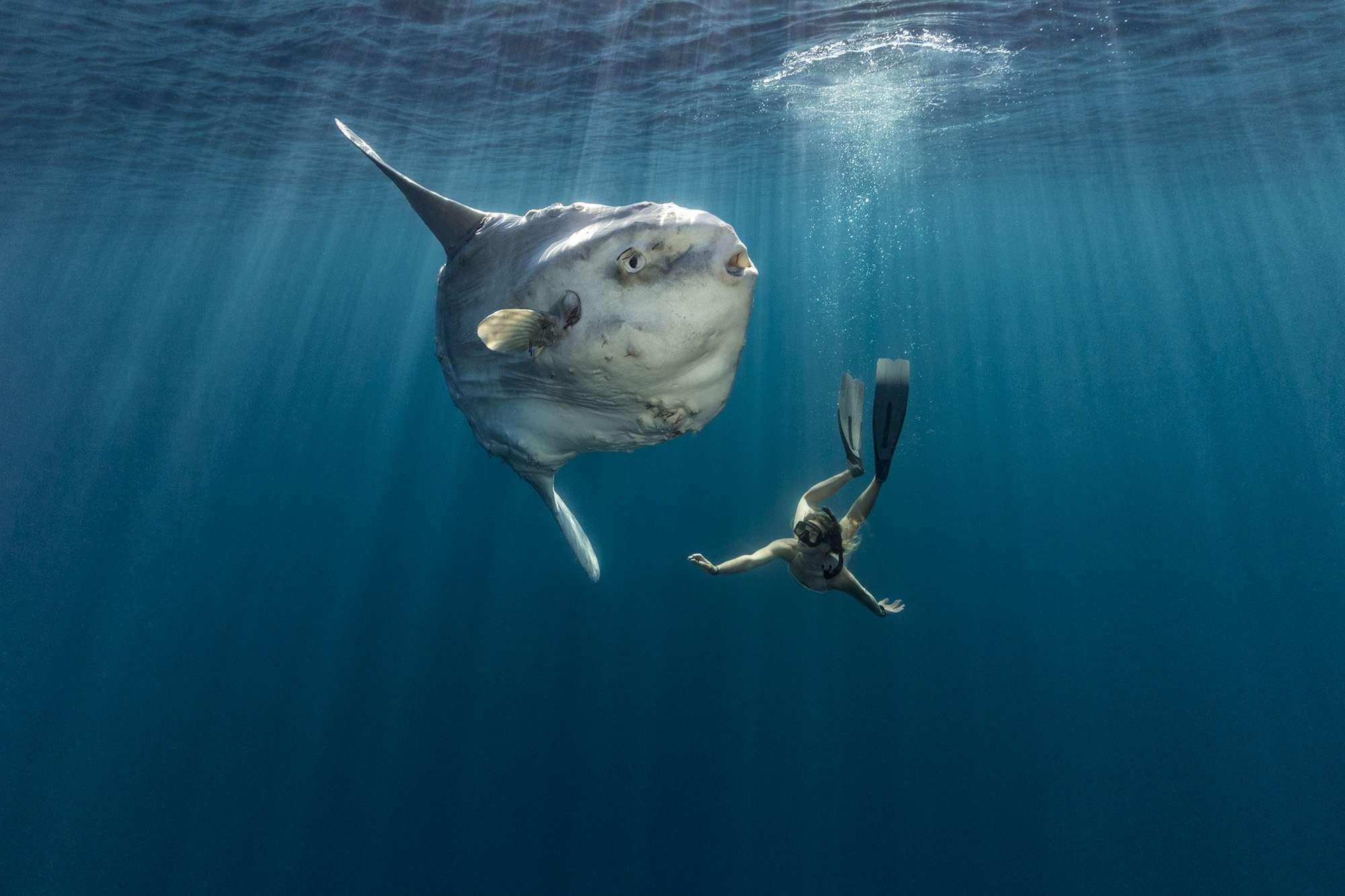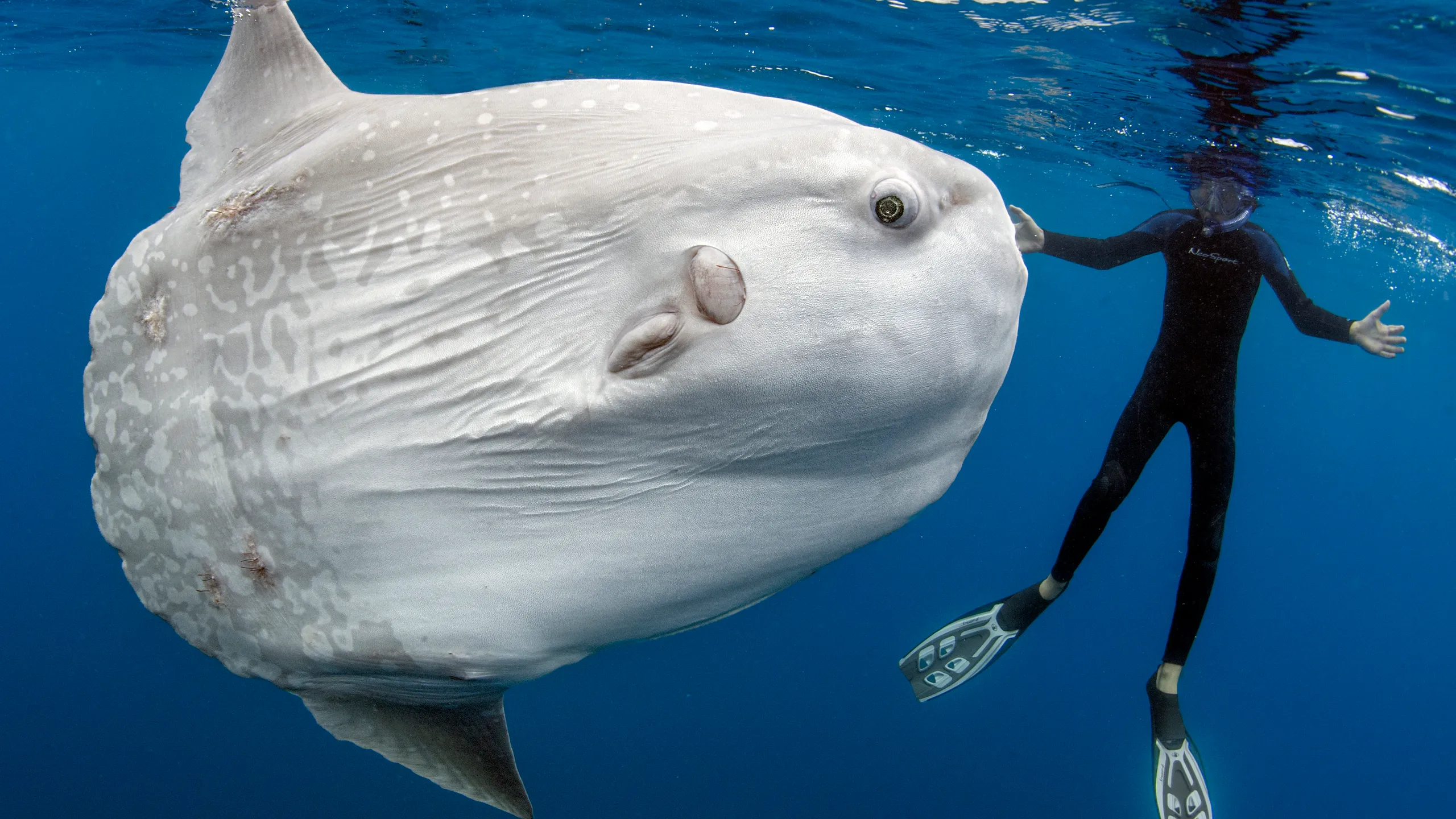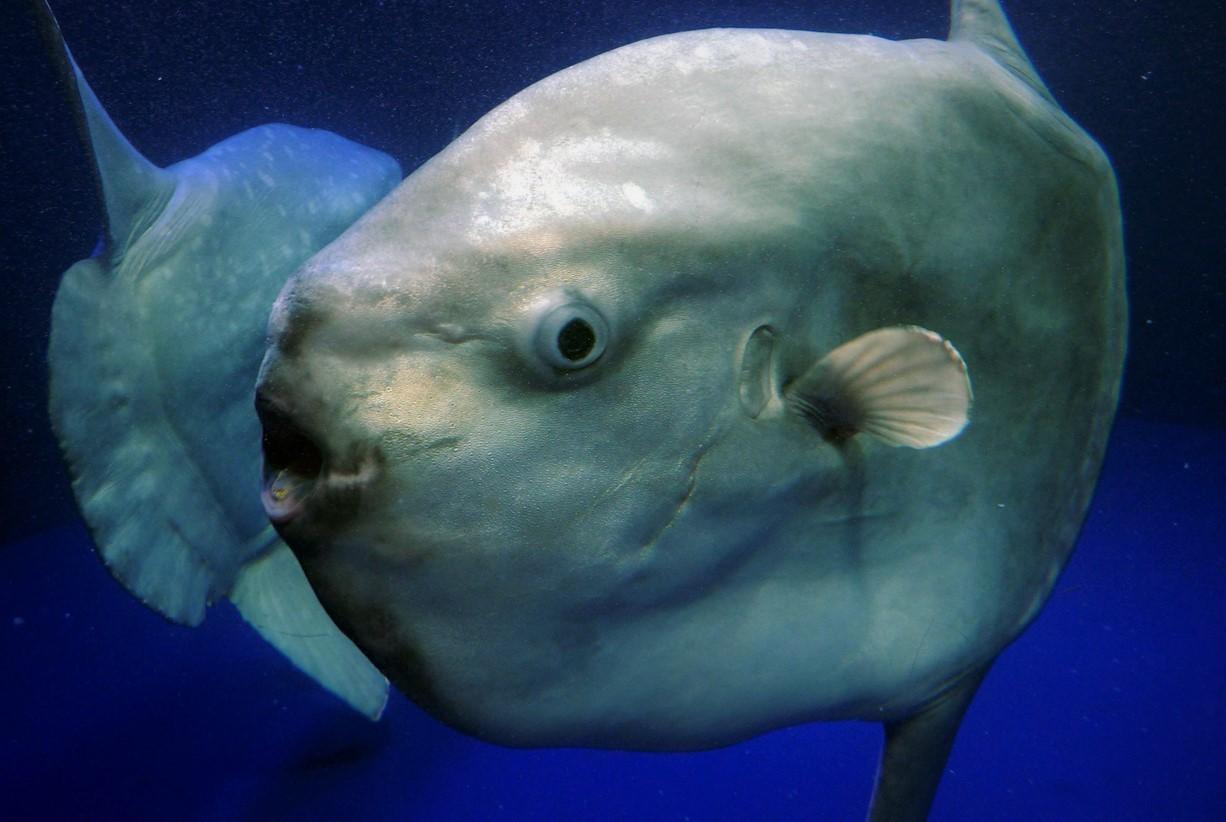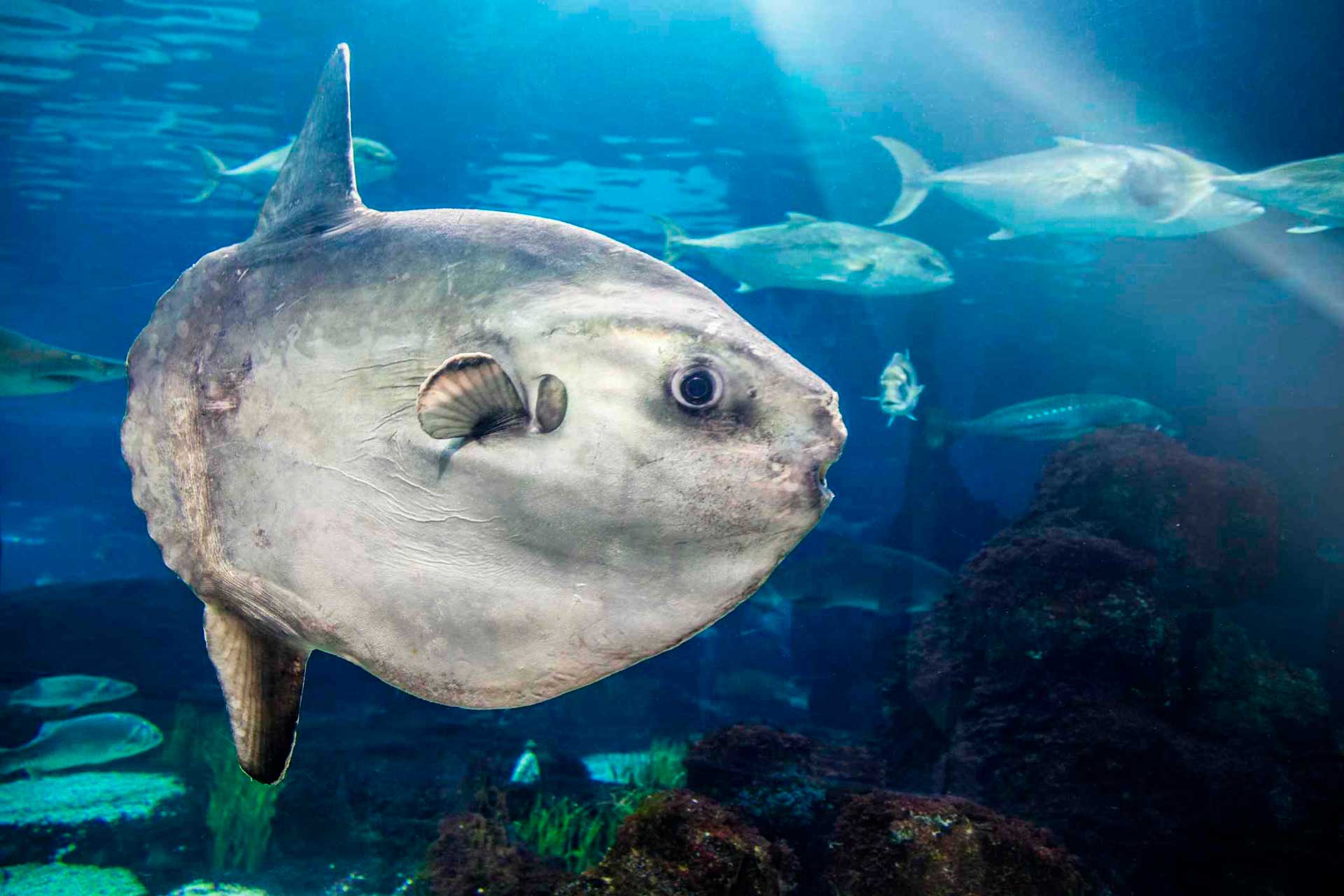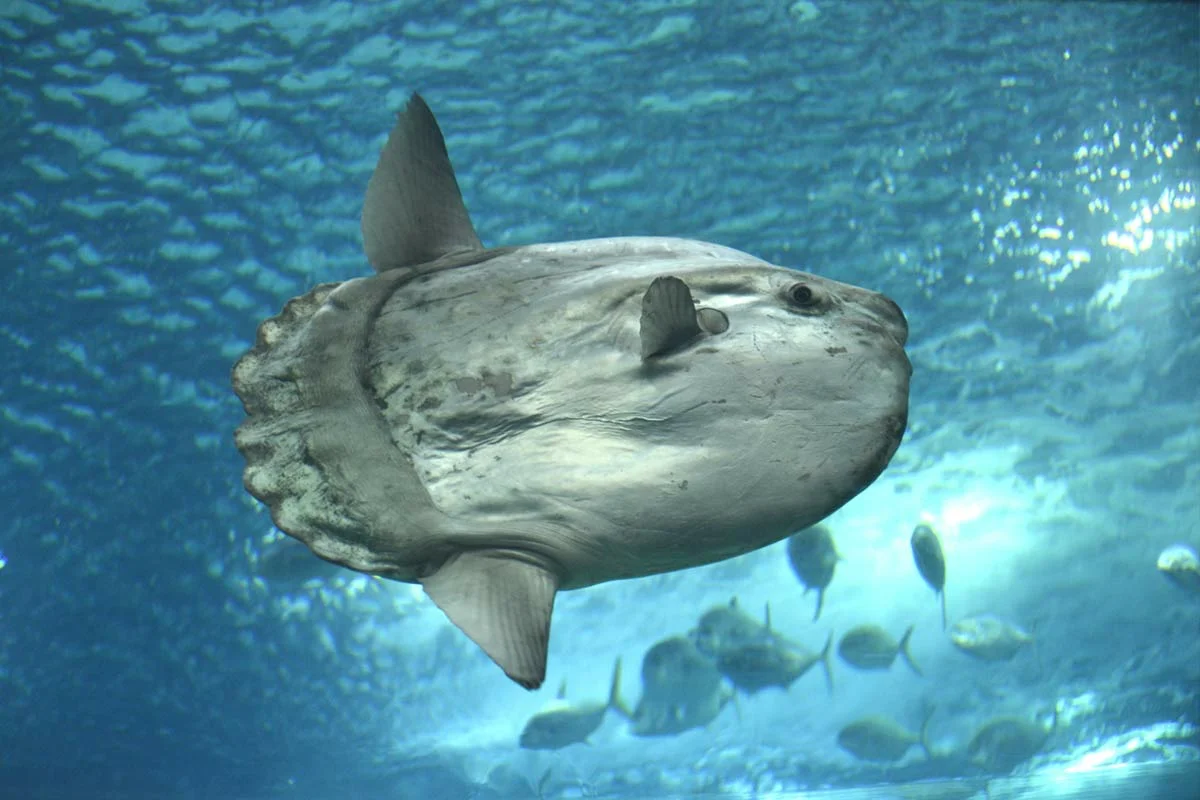The sunfish is a mysterious aquatic organism that people are persistently trying to better understand and study, despite the inaccessibility of its habitat. Nowadays people have a rather superficial understanding of the sunfish, its habits and behavior patterns; it still remains an unsolved mystery. Perhaps we will be able to lift the veil of secrecy a little and describe the appearance and features of the life of this underwater inhabitant.
History and Origin of the Moonfish
Naturalist Carl Linnaeus first documented the sunfish in 1758, naming it Tetraodon mola and describing its features. This species belongs to the class of common pufferfish, to the suborder of moon-shaped fish. It is believed to be the largest among all bony fish.
Description of the species
Lunar The fish has a round shape, a white body with gray spots, which explains its name. Its gills have no upper part. This species is able to survive in different temperatures and at different depths, so it can be found in most oceans.
The Latin name for the moonfish is mola mola, which literally means "millstone", and in Germany it is called "headfish".
This creature lives in the depths of the ocean and from time to time rises to the surface for a specific purpose - so that seagulls and other birds can land on it. Birds walk over its body, collecting parasites from under the skin, between the folds and under the fins. Having completed this procedure, the moonfish swims away to where it lives.
What does it look like
The shape of the moonfish is wide and flattened, as if stretched upward. As a result of evolution, she lost her tail fin. This happened because the pelvic bones failed to grow properly. The part that would have been occupied by the caudal fin is now filled by a fused dorsal and ventral fin located on the back. This medium-sized appendage is formed from flexible cartilage, which allows the sunfish to make very agile movements. Its spine has 16 to 18 vertebrae.
The absence of an outer surface on the gills gives them the appearance of typical openings, thereby facilitating the entry of harmful bacteria and other parasitic organisms. This can cause significant harm to the health of the moon fish.
The sunfish has tiny eyes and a small mouth, which means that other sea creatures are not afraid of it because they know that it cannot eat them. Sunfish do not have a swim bladder or lateral line, which allow aquatic creatures to sense approaching objects without seeing them. Therefore, it is easy to quietly swim up to the moonfish from the back or from the sides.
This fish is white and gray with occasional hints of brown, and some individuals may even have multi-colored patterns on their body. If the sunfish feels threatened, its color will become darker. By doing this she is trying to scare away the perceived threat.
She has no scales; instead, her body is covered with mucus, which serves a protective function. As the species ages, bony protrusions may appear; this suggests that scales were once present but were lost over time through evolution.
Dimensions
The typical length of the fish is 1.8-2 m, but they can reach 2.3-2.5 m in height. The largest size they can grow to is approximately 325 and 418 cm respectively and given their impressive size, they weigh between 240 and 1100 kg. If evolutionary processes had not replaced a significant part of the bones with cartilage, the weight could have been even more significant.
In 1966, a record size sunfish was caught. She had an impressive mass - almost two and a half thousand kilograms and looked very impressive.
Average life time
The lifespan of this creature in its natural habitat is unknown as it is difficult for researchers to observe a single specimen over a long period of time.However, by analyzing their growth rates, body structure and maturation, it has been estimated that males live up to 15 years on average, while females live about 22-24 years.
In aquariums, people have the opportunity to observe moonfish for a long time. This species of marine life has a lifespan of about 10 years when found in such an environment. By keeping it in an unnatural habitat, the researchers were able to analyze its growth rate. For every 24 hours, its size increases by approximately one millimeter, and from 18 to 485 grams is added to its weight.
Some scientists claim that the lifespan of females and males of this species can be up to 100 years and 93 years, respectively, although there is no evidence to support this claim yet.
Habitat
These fish live in the oceans and inhabit regions with warm water temperatures. They swim at depths of 45 to 250 m, but sometimes rise to a depth of 14 m from the surface.
Sunfish can be spotted in the eastern Pacific Ocean, including the area around Chile, Canada and Peru. The Indian Ocean is also home to this species, where it is found in the eastern and western coastal regions. In Atlantic waters, it lives near South Africa and Scandinavia in the east and southern Argentina in the west.
It has also been spotted in various other areas such as the Red Sea, Caribbean Sea and Baltic Sea. However, it does not exist in any part of the Arctic Ocean because this creature prefers warm waters with temperatures above 12 degrees Celsius.
It’s interesting to know: in the western part of the Atlantic there lives a significant group of these fish, numbering about eighteen thousand individuals.The size of any individual sunfish in this range does not exceed one meter.
Researchers have found that the sunfish is capable of descending to depths of up to 790 m, although it often lives at a depth of 200-215 m below the surface. If it is observed constantly floating near the top of the water and moving like a somnambulist, then this is most likely a sign of a serious illness of the individual.
Diet
The diet of the sunfish is determined by its habitat. Due to her miniature mouth, she mostly prefers soft foods, although there have been cases where she has consumed crustaceans. Sunfish generally prefer eels, krill meat, small fish, aquatic vegetation, and other sea creatures that lack hard bones or shells.
Certain types of sunfish prey often fight back in an attempt to survive. For example, squid are known to stand up to moonfish when they try to eat them, and sometimes even manage to scare them off with their aggressive tactics.
Young fish mainly consume jellyfish for food, but as they develop, this is no longer enough to satisfy their appetite, and they include other delicacies in their diet. Research has shown that they dive to different depths when hunting, resulting in a variety of prey in their stomachs throughout the day.
Because the sunfish lacks agility, so it cannot chase its prey for a long time. During feeding, she swallows a large amount of water along with any small creatures that swim nearby - they become her treat.
Lifestyle Features
Moonfish is prone to loneliness, gathering with others of its own kind only to reproduce.However, there are cases when these fish swam together and lived like this throughout their entire existence.
The sunfish stays in deep water, but will occasionally rise to the surface to soak up some sunlight and give birds a chance to help it rid itself of parasites. To do this, she lies on her side, exposing most of her body to the sun's rays.
The sunfish is a unique creature because it moves its fins in a rowing motion, unlike other fish that move their fins horizontally from side to side. This allows the sunfish to move through the water more easily, scooping up water with each stroke.
She moves very sluggishly, with an average speed of only 2.9 km/h, covering 21-26 km per day. The moonfish has a melancholy disposition and never behaves aggressively, so you can swim next to it without fear of any harm. In addition, due to her weak mobility, she cannot attack anyone, and her jaws are too weak to bite through a hard surface.
How does it reproduce
Sunfish live individually, separately from each other and gather in groups only during the breeding season, which occurs in the summer. Females lay between 315 and 323 million eggs in one location. The adults then go on their way, leaving the juveniles to immediately fend for themselves. When hatching, the larvae measure 2.2-2.6 mm and begin to eat quickly to gain weight.
The larvae closely resemble the fry of a poisonous fish called fugu, which protects them from being eaten by many underwater predators.
Enemies of fish
Because it lives in deep water and is quite large, few aquatic creatures are ready to challenge it. As a result, few underwater inhabitants pose a threat to the sunfish. These include:
- Shark - they do not attack the moonfish, since they live at different depths, but if their paths cross, the shark can easily pierce the thick skin of the moonfish with its teeth. After the shark has had its fill, the scavengers swim in to feast on the remains.
- Killer whale. Although these mammals do not eat sunfish, if one is particularly hungry or too old to chase other prey quickly, it may make an exception and pounce on the sunfish.
- Sea Lion - This predator will try to catch the sunfish as it swims to the surface of the water, biting off its fins and then attempting to tear through the skin with its teeth.
People are the main opponents of this creature. Even though the creature is not eaten, many fishing fans cannot resist the temptation to catch it due to its unusual appearance, which makes it an attractive trophy.
What is the value
In most parts of the world, sunfish are not considered edible. Therefore, if a fisherman manages to catch such a fish, then most likely it will be displayed as a trophy rather than eaten. In addition, its meat is often considered unsafe, as it may contain parasite larvae and toxins.
However, in the countries of the Far East, moonfish are eaten; they believe that all parts of its body can be used to prepare dishes.The taste of the carcass is not particularly remarkable, but the characteristic physical appearance of this fish makes its meat considered a gourmet dish. Cooking this type of food requires the cook to perform certain steps to detoxify and eliminate any harmful substances present in the sunfish.
In Europe, the sale of sunfish meat is prohibited due to lack of proper processing, which can lead to poisoning. In America, sunfish are legal for sale, but do not attract many buyers because people understand that they carry a risk of infection.
Interesting Facts
The sunfish is widespread and is not at risk of extinction in the near future. Due to the absence of predators to consume it, this species can reproduce without interruption. Even though it is caught in some places, it does not have a significant impact on the overall population.
There are often cases when these fish themselves jump onto the decks of pleasure yachts, which leads to disruption of the operation of the vessels.
Constant ocean pollution has a detrimental effect on fish. As fish suck in large amounts of water for food, they take in plastic and other pollutants, which can cause parasites to grow inside them and cause numerous diseases.

